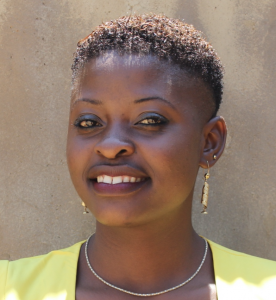Makhwabuye Community is in a rural setup whereby roads are untarmacked, some houses are semi-permanent, and others are grass-thatched. The area is evergreen, with farming shaping the landscape. The most common livelihood here is agribusiness, with many community members planting crops such as yams, sweet potatoes, vegetables, and maize. They use their crops for their consumption and sale. The village is peaceful and quiet, away from the noise of vehicles and even motorbikes.
Within Makhwabuye, 210 people depend on Sayia Spring for all of their daily water needs. Many community members have the habit of getting water very early in the morning before doing other house chores.
Prisca Luvonga, a 36-year-old businessperson and mother in the village, said she has to wake up very early to fetch way every day. She leaves her infant in the house while she is still sleeping and walks to fetch water from the spring. She says the water is cleanest at this time, and there is not always so much of a crowd as later in the morning. But there are a lot of problems with the spring once you arrive.
Sayia Spring is open to the environment, leaving it susceptible to all sorts of contamination. This makes its water unsafe for community members. Because the spring is on a gradual slope, surface runoff from the rains carry dirt from uphill directly into the water, along with farm chemicals, animal waste, and other toxins.
Apart from dirt and contaminants carried into the spring, drawing water contributes to making the water dirty. This is because people have to submerge their containers down to the ground within the spring, which looks like a shallow stream. If the water is too shallow to fill their jerrycan, they must then top it off using small jugs and bowls to scoop the water from the spring to pour into their larger jerrycan. Having to dip any container directly into the water brings all of the dirt and bacteria on the jerrycans and peoples' hands straight into the water they collect for use.
"Getting water from this water point is very tiresome, difficult, and time-consuming. This is because it is not easily accessed, for it does not have a staircase, and we scoop it into containers. This makes our productivity reduced for when you begin your day late, then performance also becomes low," explained Prisca.
Community members have tried to establish a small plank of wood to help them stay out of the water while fetching it, but the plank often and quickly rots, leaving people uneasy no matter how many times they replace the board. Mothers are fearful of sending their youngest children to the spring if the board should break, and they fall in, getting hurt or possibly drowning.
"Being a business lady, it will be beneficial when our water is protected, for I can even send children to get water as I do other chores. Currently, I cannot risk my children for it is not safe and easy for them to get water," Prisca added.
The negative consequences of having insufficient clean and safe water range from fetching water being a time-consuming task to financial instability and lack of productive time. Because Sayia Spring is difficult to access, people spend a lot of time waiting in line as person after person scoops their container full. Their daily routines are delayed, reducing the amount of work and income-earning hours for adults and time for play and homework among children.
Contaminated water and the resulting poor sanitation practices are also linked to the transmission of cholera, typhoid, diarrhea, and dysentery. When people have poor health, the strength, energy, and time needed for productive work diminish, compounding the time lost at the spring.
People here fall ill after drinking water from Sayia Spring, incurring medical costs that must be paid with money intended for other needs such as business inputs or children's school fees. Children are at a particularly high risk of contracting water-related diseases, leading to poor health, missed school lessons, and negative long-term consequences for their educations and futures.
"My performance in education really dropped due to the many times I was absent from stomach pains," said teenager Abigael.
"I was diagnosed with typhoid that did not give me peace to study for I was on and off the hospital. This also drained my parents financially while treating me and ensuring that I am well. I am therefore happy to know that our water source will be protected so we will not continue to have such cases reoccurring."
What We Can Do:
Spring Protection
Protecting the spring will help provide access to cleaner and safer water and reduce the time people have to spend to fetch it. Construction will keep surface runoff and other contaminants out of the water. With the community’s high involvement in the process, there should be a good sense of responsibility and ownership for the new clean water source.
Fetching water is a task predominantly carried out by women and young girls. Therefore, protecting the spring and offering training and support will help empower the female members of the community by freeing up more of their time and energy to engage and invest in income-generating activities and their education.
Training on Health, Hygiene, COVID-19, and More
To hold training during the pandemic, we work closely with both community leaders and the local government to approve small groups to attend training. We ask community leaders to invite a select yet representative group of people to attend training, which will then act as ambassadors to the rest of the community to share what they learn. We also communicate our expectations of physical distancing and wearing masks for all who choose to attend.
The training will focus on improved hygiene, health, and sanitation habits in this community. We will also have a dedicated session on COVID-19 symptoms, transmission routes, and prevention best practices.
With the community’s input, we will identify key leverage points to alter their practices at the personal, household, and community levels to affect change. This training will help to ensure participants have the knowledge they need about healthy practices and their importance to make the most of their water point as soon as the water is flowing.
Our team of facilitators will use a variety of methods to train community members. Some of these methods include participatory hygiene and sanitation transformation, asset-based community development, group discussions, handouts, and demonstrations at the spring.
One of the most important issues we plan to cover is handling, storing, and treating water. Having a clean water source will be extremely helpful, but it is useless if water gets contaminated by the time it is consumed. The community and we strongly believe that all of these components will work together to improve living standards here, which will help to unlock the potential for these community members to live better, healthier lives.
We will then conduct a small series of follow-up training before transitioning to our regularly scheduled support visits throughout the year.
Training will result in the formation of a water user committee, elected by their peers, that will oversee the spring's operations and maintenance. The committee will enforce proper behavior around the spring and delegate tasks that will help preserve the site, such as building a fence and digging proper drainage channels. The fence will keep out destructive animals and unwanted waste, and the drainage will keep the area’s mosquito population at a minimum.

 Protected Spring
Protected Spring
 Rehabilitation Project
Rehabilitation Project












































